A Study on Outdoor Thermal Comfort of College Students in the Outdoor Corridors of Teaching Buildings in Hot and Humid Regions
Abstract
1. Introduction
2. Methods
2.1. Study Area
2.2. Instruments and Measured Parameters
2.3. Questionnaire and Experimental Procedure
2.4. Data Processing
2.4.1. The Principle of Metabolic Rate Measurement
2.4.2. Thermal Indices
3. Results
3.1. Field Thermal Parameters
3.2. Subjects’ Information
3.3. Votes
3.3.1. Preference Votes
3.3.2. Physical Fatigue Evaluation Votes
3.3.3. Psychological Evaluation Votes
3.3.4. Thermal Sensation Votes and Wind Sensation Votes
3.3.5. Thermal Adaptation Behavior Votes
3.4. Thermal Parameters with MTSV
3.5. MWSV and Unacceptable Wind Speed
3.6. Heart Rate and Metabolic Rate
3.7. MTSV with PET and UTCI
3.8. Unacceptable PET and UTCI
4. Discussion
5. Limitations and Future Research
6. Conclusions
- (1)
- In corridor spaces, Ta and Va are the primary thermal environment parameters influencing colleges’ thermal sensation;
- (2)
- Males and females perceive hot when their PET (UTCI) values reach 33.5 (34.5) °C and 33.3 (33.5) °C, respectively. When the PET (UTCI) values reach 39.0 °C (37.5 °C) for males and 37.7 °C (38.3 °C) for females, individuals in corridor spaces will face extreme heat stress;
- (3)
- The unacceptable PET for males and females are 31.1 °C and 31.8 °C, respectively, indicating that females find high-temperature environments more difficult to tolerate than males;
- (4)
- In hot outdoor environments, females are more prone than males to experience fatigue and negative emotions.
Author Contributions
Funding
Data Availability Statement
Conflicts of Interest
References
- Yang, J.; Zhao, Y.; Guo, T.; Luo, X.; Ji, K.; Zhou, M.; Wan, F. The impact of tree species and planting location on outdoor thermal comfort of a semi-outdoor space. Int. J. Biometeorol. 2023, 67, 1689–1701. [Google Scholar] [CrossRef] [PubMed]
- Lin, P.; Song, D.; Qin, H. Impact of parking and greening design strategies on summertime outdoor thermal condition in old mid-rise residential estates. Urban. For. Urban. Gree 2021, 63, 127200. [Google Scholar] [CrossRef]
- Chen, X.; Zhao, H.; Li, P.; Yin, Z. Remote sensing image-based analysis of the relationship between urban heat island and land use/cover changes. Remote Sens. Environ. 2006, 104, 133–146. [Google Scholar] [CrossRef]
- Rizwan, A.M.; Dennis, Y.; Liu, C.H. A review on the generation, determination and mitigation of Urban Heat Island. J. Environ. Sci. 2008, 20, 120–128. [Google Scholar] [CrossRef]
- Zhao, L.; Lee, X.; Smith, R.B.; Oleson, K. Strong contributions of local background climate to urban heat islands. Nature 2014, 511, 216–219. [Google Scholar] [CrossRef] [PubMed]
- Tian, X.; Zhang, H.; Liu, L.; Huang, J.; Liu, L.; Liu, J. Establishment of LCZ-based urban building energy consumption dataset in hot and humid subtropical regions through a bottom-up method. Appl. Energ. 2024, 368, 123491. [Google Scholar] [CrossRef]
- Wang, Q.; Peng, L.L.H.; Jiang, W.; Yin, S.; Feng, N.; Yao, L. Urban form affects the cool island effect of urban greenery via building shadows. Build. Environ. 2024, 254, 111398. [Google Scholar] [CrossRef]
- Abdallah, A.S.H.; Mahmoud, R.M.A. Urban morphology as an adaptation strategy to improve outdoor thermal comfort in urban residential community of new assiut city, Egypt. Sustain. Cities Soc. 2022, 78, 103648. [Google Scholar] [CrossRef]
- Teshnehdel, S.; Akbari, H.; Di Giuseppe, E.; Brown, R.D. Effect of tree cover and tree species on microclimate and pedestrian comfort in a residential district in Iran. Build. Environ. 2020, 178, 106899. [Google Scholar] [CrossRef]
- Zhang, K.; Qi, F.; Zhang, T.; Zhou, L. The impact of trees on the peak cooling load of detached rural residences. Energ. Build. 2024, 317, 114311. [Google Scholar] [CrossRef]
- Ali-Toudert, F.; Mayer, H. Numerical study on the effects of aspect ratio and orientation of an urban street canyon on outdoor thermal comfort in hot and dry climate. Build. Environ. 2007, 42, 1553–1554. [Google Scholar] [CrossRef]
- Niu, J.; Hong, B.; Geng, Y.; Mi, J.; He, J. Summertime physiological and thermal responses among activity levels in campus outdoor spaces in a humid subtropical city. Sci. Total Environ. 2020, 728, 138757. [Google Scholar] [CrossRef]
- Guo, T.; Lin, Z.; Zhao, Y.; Fang, Z.; Fan, Y.; Zhang, X.; Yang, J.; Li, Y. Investigation and optimization of outdoor thermal comfort in elementary school campuses: Example from a humid-hot area in China. Build. Environ. 2024, 248, 111055. [Google Scholar] [CrossRef]
- Cohen, P.; Cohen, S.; Shashua-Bar, L.; Tanny, J.; Potchter, O. Outdoor thermal perception and adaptation of immigrants from cold climates to hot arid climate. Build. Environ. 2023, 243, 110631. [Google Scholar] [CrossRef]
- Yuan, T.; Hong, B.; Li, Y.; Wang, Y.; Wang, Y. The Right Activities at Right Spaces: Relationships between Elderly Adults’ Physical Activities and Thermal Responses. Buildings 2023, 13, 721. [Google Scholar] [CrossRef]
- Pontzer, H.; Yamada, Y.; Sagayama, H.; Ainslie, P.N.; Andersen, L.F.; Anderson, L.J.; Arab, L.; Baddou, I.; Bedu-Addo, K.; Blaak, E.E.; et al. Daily energy expenditure through the human life course. Science 2021, 373, 808. [Google Scholar] [CrossRef] [PubMed]
- Wang, D.; Jiang, J.; Liu, Y.; Wang, Y.; Xu, Y.; Liu, J. Student responses to classroom thermal environments in rural primary and secondary schools in winter. Build. Environ. 2017, 115, 104–117. [Google Scholar] [CrossRef]
- Fang, Z.; Tang, T.; Zheng, Z.; Zhou, X.; Liu, W.; Zhang, Y. Thermal responses of workers during summer: An outdoor investigation of construction sites in South China. Sustain. Cities Soc. 2021, 66, 102705. [Google Scholar] [CrossRef]
- Fang, Z.; Feng, X.; Xu, X.; Zhou, X.; Lin, Z.; Ji, Y. Investigation into outdoor thermal comfort conditions by different seasonal field surveys in China, Guangzhou. Int. J. Biometeorol. 2019, 63, 1357–1368. [Google Scholar] [CrossRef]
- Dong, Z.; Zhao, K.; Ren, M.; Ge, J.; Chan, I.Y.S. The impact of space design on occupants’ satisfaction with indoor environment in university dormitories. Build. Environ. 2022, 218, 109143. [Google Scholar] [CrossRef]
- Weitzman, E.R. Poor mental health, depression, and associations with alcohol consumption, harm, and abuse in a national sample of young adults in college. J. Nerv. Ment. Dis. 2004, 192, 269–277. [Google Scholar] [CrossRef]
- Sun, N.; Liu, W.; Zheng, Z. Campus outdoor environment, learning engagement, and the mental health of college students during the COVID-19 pandemic: From the perspective of students in different grades. Front. Public Health 2023, 11, 1143635. [Google Scholar] [CrossRef]
- Liu, X.; Ping, S.; Gao, W. Changes in Undergraduate Students’ Psychological Well-Being as They Experience University Life. Int. J. Environ. Res. Public Health 2019, 16, 2864. [Google Scholar] [CrossRef] [PubMed]
- Mullins, J.T.; White, C. Temperature and mental health: Evidence from the spectrum of mental health outcomes. J. Health Econ. 2019, 68, 102240. [Google Scholar] [CrossRef] [PubMed]
- Wen, Q.; Zhou, Q.; Ye, H.; Guo, Q.; Shan, J.; Huang, Z. A Perceptual Assessment of the Physical Environment in Teaching Buildings and Its Influence on Students’ Mental Well-Being. Buildings 2024, 14, 1790. [Google Scholar] [CrossRef]
- Hoisington, A.J.; Stearns-Yoder, K.A.; Schuldt, S.J.; Beemer, C.J.; Maestre, J.P.; Kinney, K.A.; Postolache, T.T.; Lowry, C.A.; Brenner, L.A. Ten questions concerning the built environment and mental health. Build. Environ. 2019, 155, 58–69. [Google Scholar] [CrossRef]
- Noelke, C.; McGovern, M.; Corsi, D.J.; Jimenez, M.P.; Stern, A.; Wing, I.S.; Berkman, L. Increasing ambient temperature reduces emotional well-being. Environ. Res. 2016, 151, 124–129. [Google Scholar] [CrossRef] [PubMed]
- Chang, C.C.; Oh, R.; Nghiem, T.; Zhang, Y.C.; Tan, C.; Lin, B.B.; Gaston, K.J.; Fuller, R.A.; Carrasco, L.R. Life satisfaction linked to the diversity of nature experiences and nature views from the window. Landsc. Urban. Plan. 2020, 202, 103874. [Google Scholar] [CrossRef]
- Thivel, D.; Tremblay, A.; Genin, P.M.; Panahi, S.; Riviere, D.; Duclos, M. Physical Activity, Inactivity, and Sedentary Behaviors: Definitions and Implications in Occupational Health. Front. Public Health 2018, 6, 288. [Google Scholar] [CrossRef]
- Cheng, F.; Li, Y.; Wu, Y.; Cheng, Y.; Lin, Z. Experimental study of air distribution and heating performances of deflection ventilation. Energ. Build. 2023, 282, 112800. [Google Scholar] [CrossRef]
- Guo, J.; Xia, D.; Zhang, L.; Zou, Y.; Yang, X.; Xie, W.; Zhong, Z. Future indoor overheating risk for urban village housing in subtropical region of China under long-term changing climate. Build. Environ. 2023, 246, 110978. [Google Scholar] [CrossRef]
- Tang, T.; Zhou, X.; Zhang, Y.; Feng, X.; Liu, W.; Fang, Z.; Zheng, Z. Investigation into the thermal comfort and physiological adaptability of outdoor physical training in college students. Sci. Total Environ. 2022, 839, 155979. [Google Scholar] [CrossRef] [PubMed]
- Zhang, Y.; Zhou, X.; Zheng, Z.; Oladokun, M.O.; Fang, Z. Experimental investigation into the effects of different metabolic rates of body movement on thermal comfort. Build. Environ. 2020, 168, 106489. [Google Scholar] [CrossRef]
- Zhao, Y.; Yang, J.; Fang, Z.; Zhang, X.; Guo, T.; Li, Y. Passive design strategies to improve student thermal comfort: A field study in semi-outdoor spaces of academic buildings in hot-humid areas. Urban. Clim. 2024, 53, 101807. [Google Scholar] [CrossRef]
- Gan, S.; Chen, W.; Feng, J. Case Study of Space Optimization Simulation of Existing Office Buildings Based on Thermal Buffer Effect. Buildings 2024, 14, 1611. [Google Scholar] [CrossRef]
- Rizzo, K.; Camilleri, M.; Gatt, D.; Yousif, C. Optimising Mechanical Ventilation for Indoor Air Quality and Thermal Comfort in a Mediterranean School Building. Sustainability 2024, 16, 766. [Google Scholar] [CrossRef]
- Prasetya, A.; Ho, A.D.; Kubota, T. Analysis of Typical Layout of Apartment Buildings in Indonesia. Buildings 2023, 13, 1387. [Google Scholar] [CrossRef]
- Zare, S.; Shirvan, H.E.; Hemmatjo, R.; Nadri, F.; Jahani, Y.; Jamshidzadeh, K.; Paydar, P. A comparison of the correlation between heat stress indices (UTCI, WBGT, WBDT, TSI) and physiological parameters of workers in Iran. Weather Clim. Extrem. 2019, 26, 100213. [Google Scholar] [CrossRef]
- Takakura, J.; Fujimori, S.; Takahashi, K.; Hijioka, Y.; Hasegawa, T.; Honda, Y.; Masui, T. Cost of preventing workplace heat -related illness through worker breaks and the benefit of climate-change mitigation. Environ. Res. Lett. 2017, 12, 064010. [Google Scholar] [CrossRef]
- Blazejczyk, K.; Epstein, Y.; Jendritzky, G.; Staiger, H.; Tinz, B. Comparison of UTCI to selected thermal indices. Int. J. Biometeorol. 2012, 56, 515–535. [Google Scholar] [CrossRef] [PubMed]
- Höppe, P. The physiological equivalent temperature -: A universal index for the biometeorological assessment of the thermal environment. Int. J. Biometeorol. 1999, 43, 71–75. [Google Scholar] [CrossRef]
- Zhang, Y.; He, H.; Dai, K.; Lin, Z.; Fang, Z.; Zheng, Z. Thermal responses of face-masked pedestrians during summer: An outdoor investigation under tree-shaded areas. Build. Environ. 2023, 233, 110058. [Google Scholar] [CrossRef]
- Zhang, S.; Zhang, X.; Niu, D.; Fang, Z.; Chang, H.; Lin, Z. Physiological equivalent temperature-based and universal thermal climate index-based adaptive-rational outdoor thermal comfort models. Build. Environ. 2023, 228, 109900. [Google Scholar] [CrossRef]
- Lam, C.K.C.; Gao, Y.; Yang, H.; Chen, T.; Zhang, Y.; Ou, C.; Hang, J. Interactive effect between long-term and short-term thermal history on outdoor thermal comfort: Comparison between Guangzhou, Zhuhai and Melbourne. Sci. Total Environ. 2021, 760, 144141. [Google Scholar] [CrossRef] [PubMed]
- Li, K.; Zhang, Y.; Zhao, L. Outdoor thermal comfort and activities in the urban residential community in a humid subtropical area of China. Energ. Build. 2016, 133, 498–511. [Google Scholar] [CrossRef]
- ISO 7726; Ergonomics of the Thermal Environment—Instruments for Measuring Physical Quantities. ISO: Geneva, Switzerland, 1998.
- Zhang, Y.; Liu, J.; Zheng, Z.; Fang, Z.; Zhang, X.; Gao, Y.; Xie, Y. Analysis of thermal comfort during movement in a semi-open transition space. Energ. Build. 2020, 225, 110312. [Google Scholar] [CrossRef]
- Liu, W.; Zhang, Y.; Deng, Q. The effects of urban microclimate on outdoor thermal sensation and neutral temperature in hot-summer and cold-winter climate. Energ. Build. 2016, 128, 190–197. [Google Scholar] [CrossRef]
- Aljawabra, F.; Nikolopoulou, M. Thermal comfort in urban spaces: A cross-cultural study in the hot arid climate. Int. J. Biometeorol. 2020, 64, 305. [Google Scholar] [CrossRef]
- Wei, D.; Lian, Z.; Liu, B. A Field Study of Outdoor Human Thermal Perception in Three Seasons in Shanghai, China. Buildings 2022, 12, 1453. [Google Scholar] [CrossRef]
- Fang, Z.; Xu, X.; Zhou, X.; Deng, S.; Wu, H.; Liu, J.; Lin, Z. Investigation into the thermal comfort of university students conducting outdoor training. Build. Environ. 2019, 149, 26–38. [Google Scholar] [CrossRef]
- Wei, C.; Zhao, L.; Chang, H.; Xumo, P. Thermal comfort analysis and improvement of outdoor sports spaces in universities: A case study of Xi’an Jiaotong University. Environ. Sci. Pollut. Res. 2023, 30, 76575–76594. [Google Scholar] [CrossRef] [PubMed]
- Gao, S.; Yang, L.; Li, Y.; Liu, S.; Zhang, H.; Arens, E.; Zhai, Y. Metabolic rate in children and adolescents: Tabulate values for common activities and comparisons with standards and adult values. Build. Environ. 2023, 244, 110804. [Google Scholar] [CrossRef]
- Tung, C.; Chen, C.; Tsai, K.; Kantor, N.; Hwang, R.; Matzarakis, A.; Lin, T. Outdoor thermal comfort characteristics in the hot and humid region from a gender perspective. Int. J. Biometeorol. 2014, 58, 1927–1939. [Google Scholar] [CrossRef]
- Elnabawi, M.H.; Aoul, K.A.T.; Alhumaidi, A.; Osman, B.; Alshehhi, R.; Almahri, S. A behavioural analysis of outdoor thermal comfort in a hot, arid climate: A culture and gender equality perspective. Archit. Sci. Rev. 2024, 67, 1–15. [Google Scholar] [CrossRef]
- Luo, X.; Zhao, Y.; Yang, J.; Li, Y.; Luo, Z. Adaptive design strategies for thermal comfort in waterfront campsites during summer in hot and humid regions. Int. J. Therm. Sci. 2024, 199, 108945. [Google Scholar] [CrossRef]
- Shi, Y.; Xiang, Y.; Zhang, Y. Urban Design Factors Influencing Surface Urban Heat Island in the High-Density City of Guangzhou Based on the Local Climate Zone. Sensors 2019, 19, 3459. [Google Scholar] [CrossRef]
- Tang, H.; Gao, Y.; Tan, S.; Guo, Y.; Gao, W. Field Investigation on Adaptive Thermal Comfort in Rural Dwellings: A Case Study in Linyi (China) during Summer. Buildings 2024, 14, 142. [Google Scholar] [CrossRef]


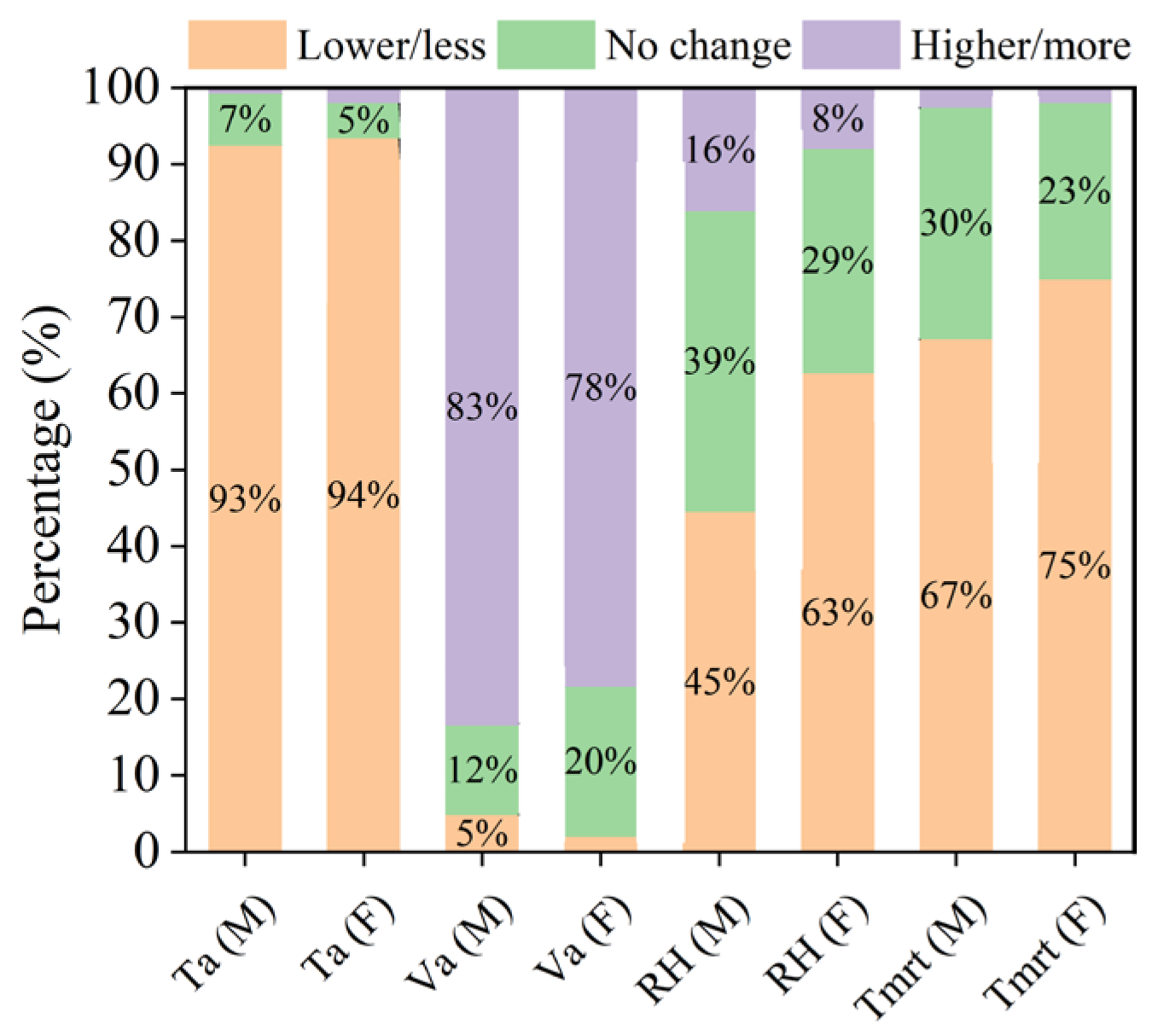
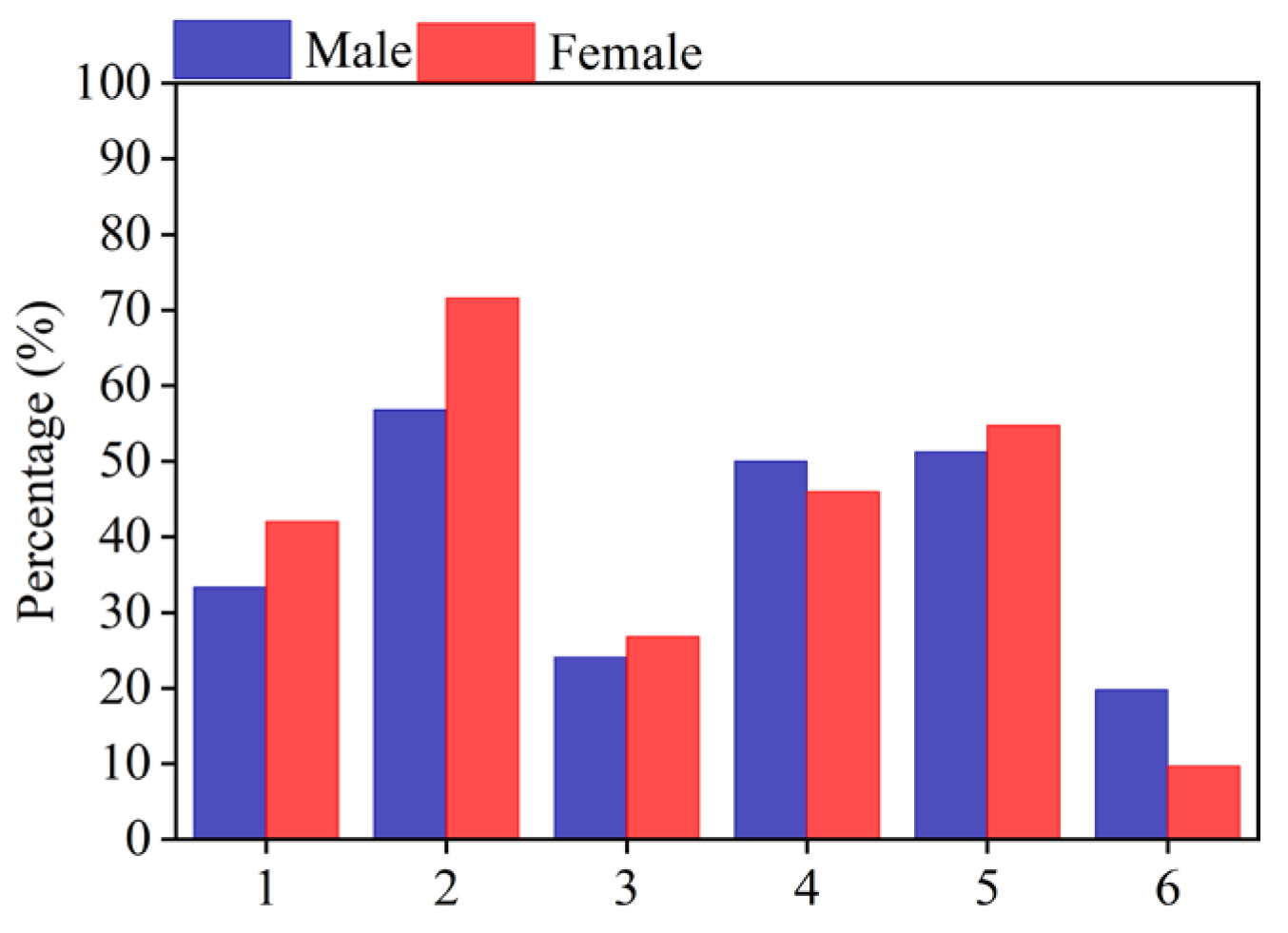
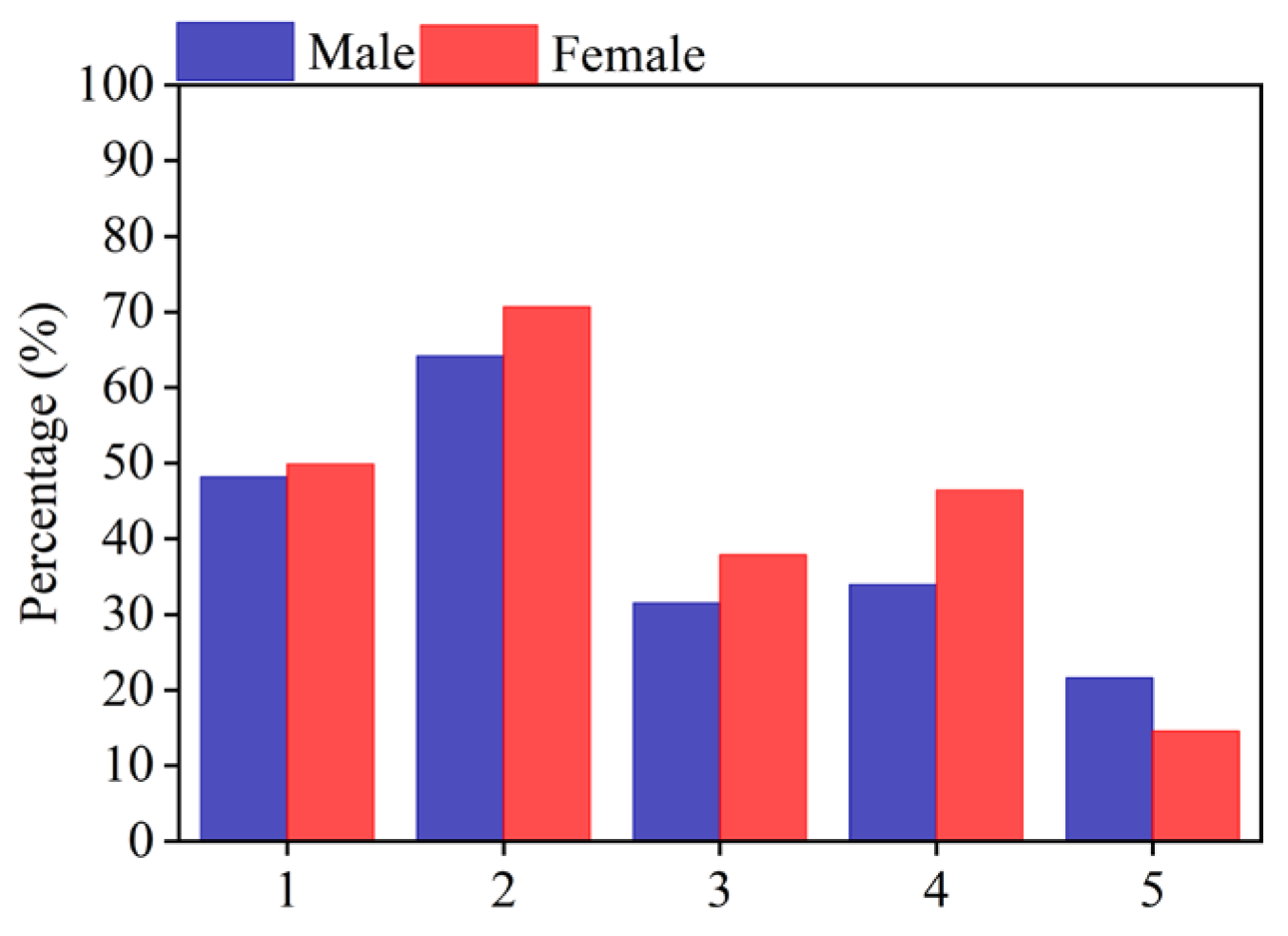

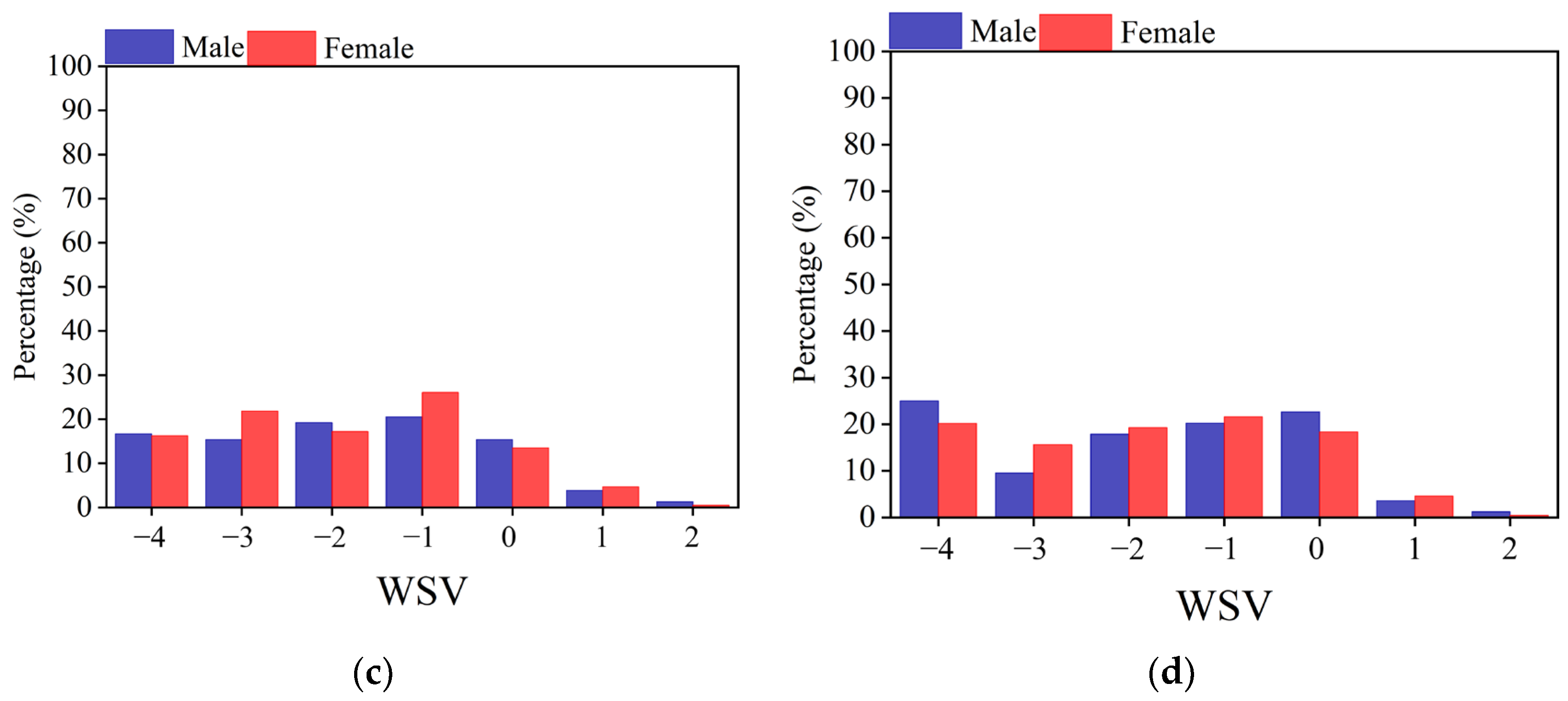
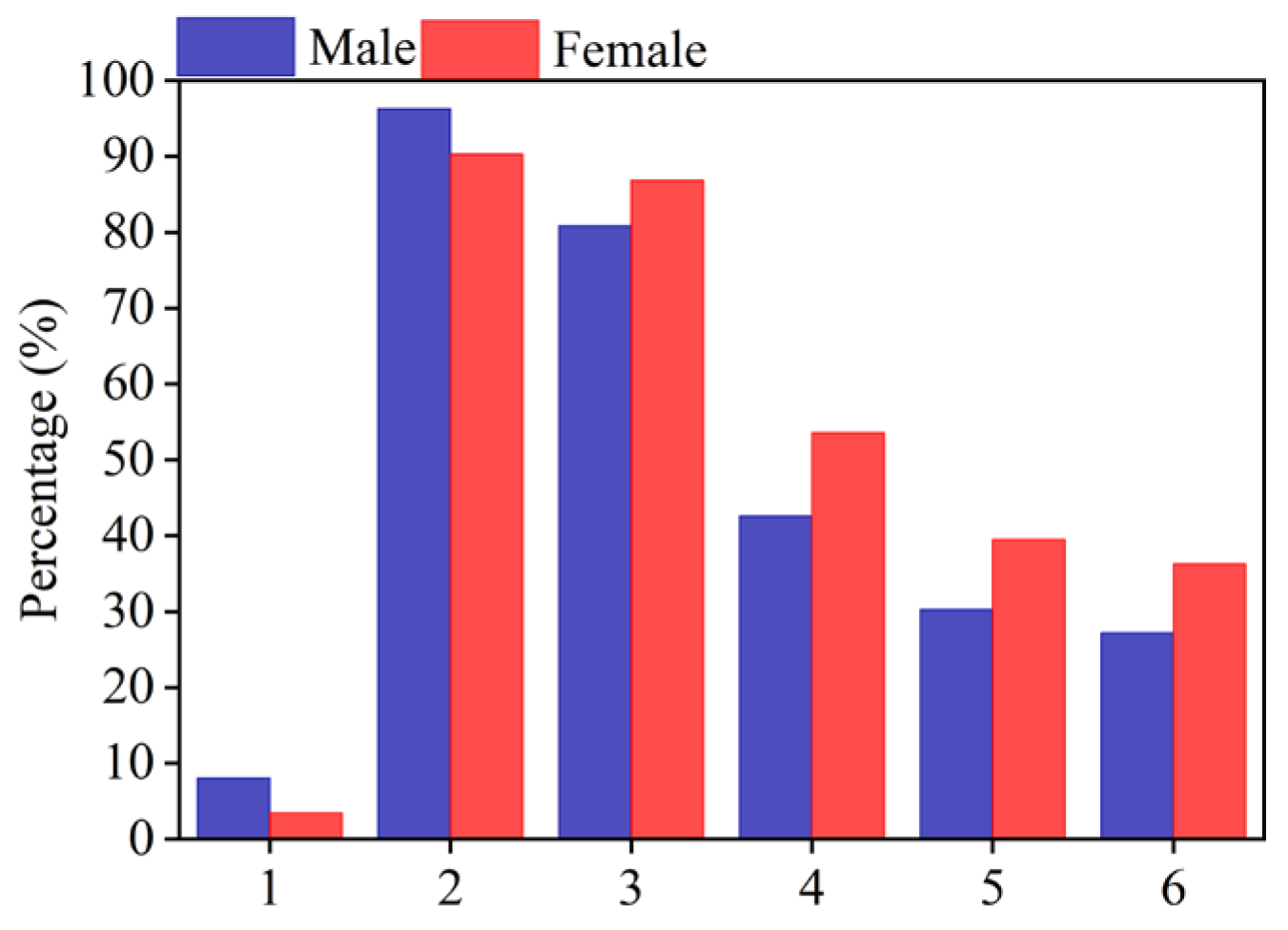
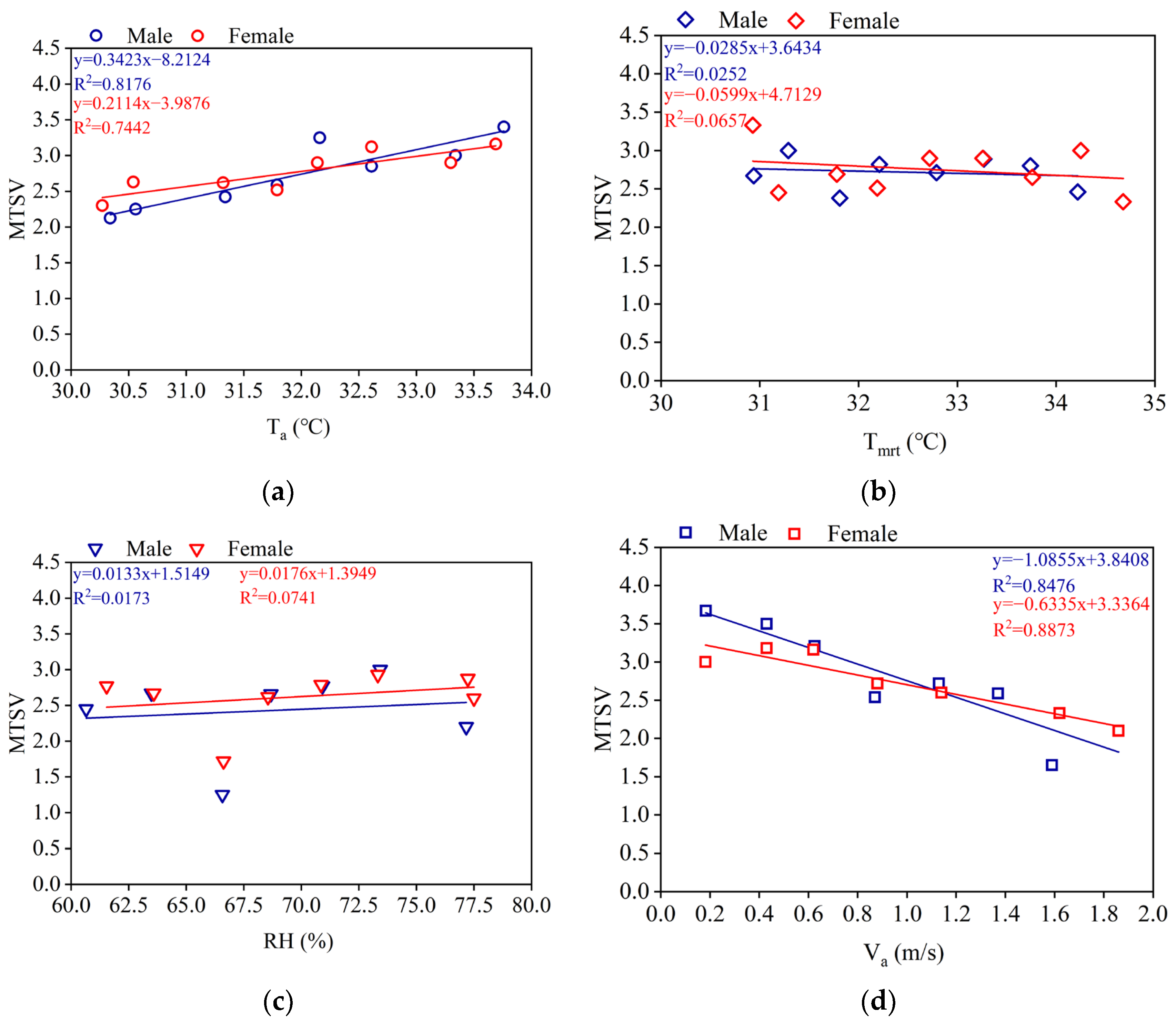
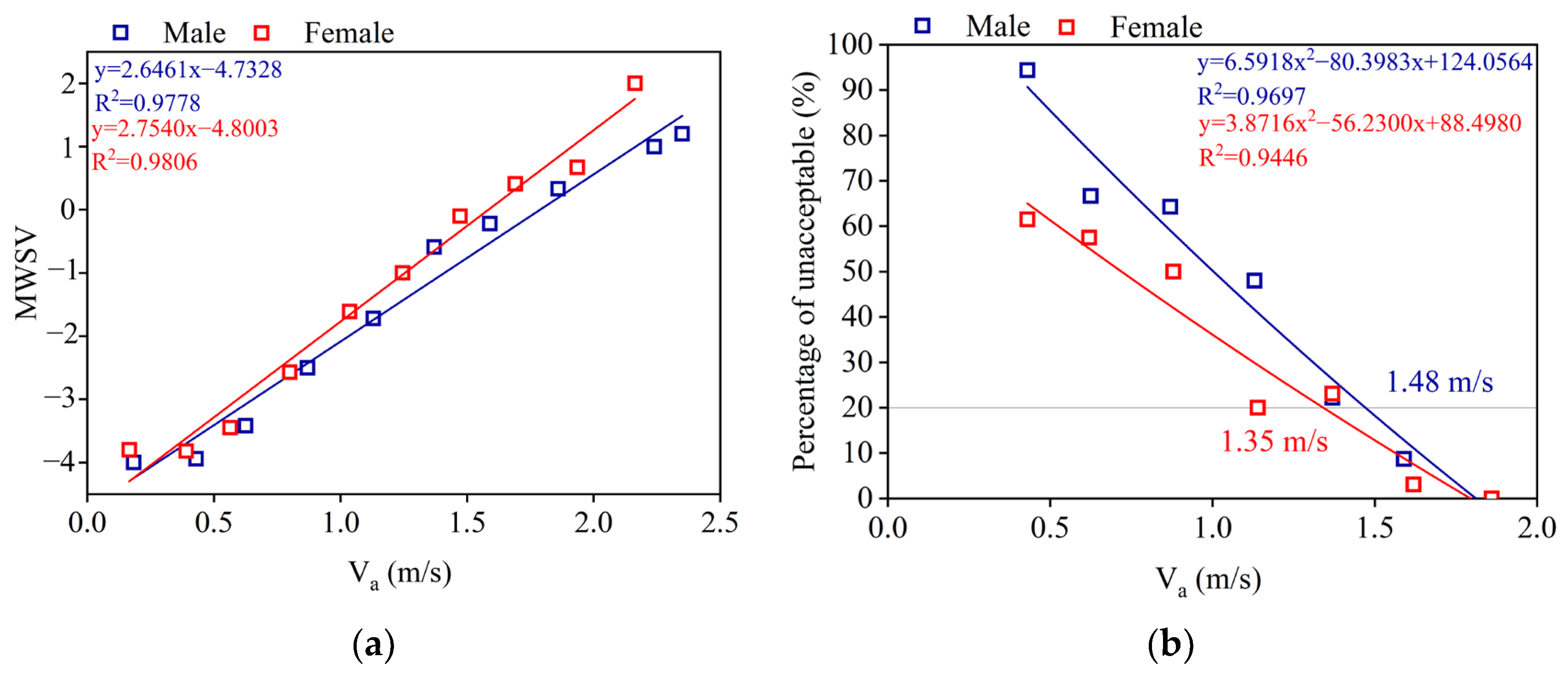

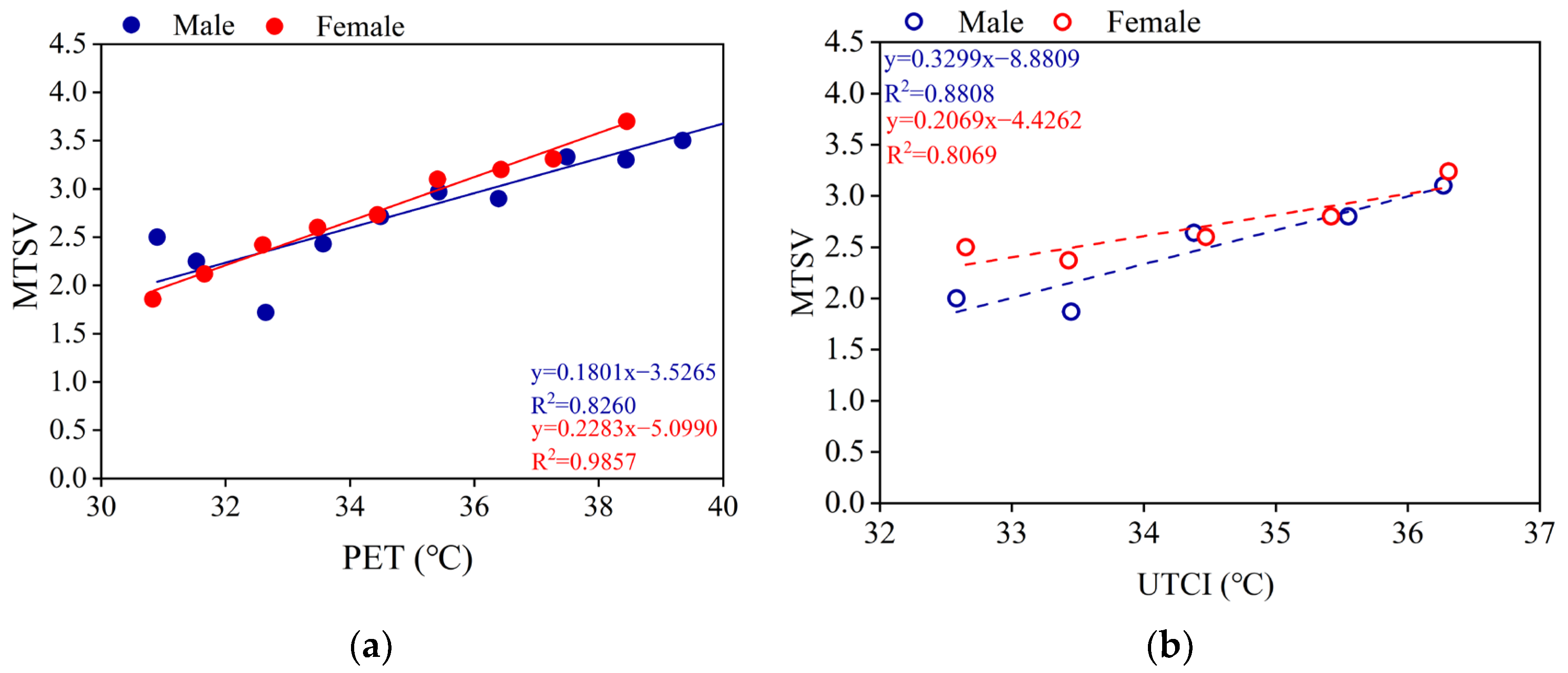

| Instrument | Type | Parameter | Measurement Range | Accuracy | Sampling Rate (s) |
|---|---|---|---|---|---|
| Thermal comfort level recorder | SSDZY-1 | Air temperature (Ta) | −20 °C~+80 °C | ±0.3 °C | 60 |
| Relative humidity (RH) | 0.01–99.9% | ±2% (10–90%) | 60 | ||
| Black globe temperature (Tg) | −20–80 °C | ±0.3 °C | 60 | ||
| Wind speed (Va) | 0.05–5 m/s | 5% ± 0.05 m/s | 60 |
| Sex | Number | Average Age in Years (SD) | Average Height in m (SD) | Average Weight in kg (SD) |
|---|---|---|---|---|
| Male | 162 | 19.6 (1.88) | 1.75 (0.07) | 64.7 (10.65) |
| Female | 433 | 19.2 (1.65) | 1.63 (0.05) | 53.8 (9.04) |
| Thermal Sensation | Heat Stress | PET (Male) | PET (Female) | UTCI (Male) | UTCI (Female) |
|---|---|---|---|---|---|
| Neutral (−0.5–0.5) | No thermal stress | - | - | - | - |
| Slightly warm (0.5–1.5) | Slight heat stress | - | - | - | - |
| Warm (1.5–2.5) | Moderate heat stress | 27.9–33.5 | 28.9–33.3 | 31.5–34.5 | 28.6–33.5 |
| Hot (2.5–3.5) | Strong heat stress | 33.5–39.0 | 33.3–37.7 | 34.5–37.5 | 33.5–38.3 |
| Very hot (3.5–4.5) | Extreme heat stress | >39.0 | >37.7 | >37.5 | >38.3 |
Disclaimer/Publisher’s Note: The statements, opinions and data contained in all publications are solely those of the individual author(s) and contributor(s) and not of MDPI and/or the editor(s). MDPI and/or the editor(s) disclaim responsibility for any injury to people or property resulting from any ideas, methods, instructions or products referred to in the content. |
© 2024 by the authors. Licensee MDPI, Basel, Switzerland. This article is an open access article distributed under the terms and conditions of the Creative Commons Attribution (CC BY) license (https://creativecommons.org/licenses/by/4.0/).
Share and Cite
Zhang, Q.; Li, Y.; Lin, C. A Study on Outdoor Thermal Comfort of College Students in the Outdoor Corridors of Teaching Buildings in Hot and Humid Regions. Buildings 2024, 14, 2756. https://doi.org/10.3390/buildings14092756
Zhang Q, Li Y, Lin C. A Study on Outdoor Thermal Comfort of College Students in the Outdoor Corridors of Teaching Buildings in Hot and Humid Regions. Buildings. 2024; 14(9):2756. https://doi.org/10.3390/buildings14092756
Chicago/Turabian StyleZhang, Qiuwan, Yuxi Li, and Chang Lin. 2024. "A Study on Outdoor Thermal Comfort of College Students in the Outdoor Corridors of Teaching Buildings in Hot and Humid Regions" Buildings 14, no. 9: 2756. https://doi.org/10.3390/buildings14092756
APA StyleZhang, Q., Li, Y., & Lin, C. (2024). A Study on Outdoor Thermal Comfort of College Students in the Outdoor Corridors of Teaching Buildings in Hot and Humid Regions. Buildings, 14(9), 2756. https://doi.org/10.3390/buildings14092756





